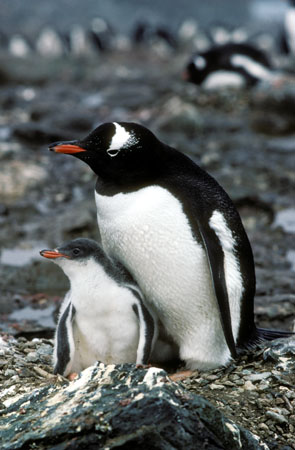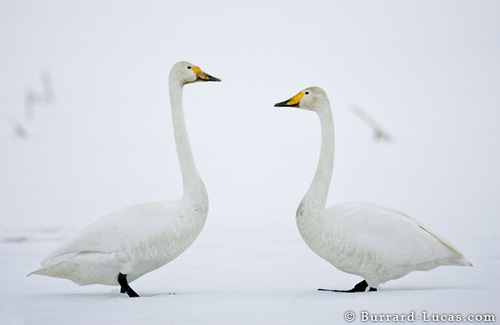In at least some respects, framing and composition for bird photography are similar to the approaches used in portraiture. In other ways the two subject areas are of course quite different. While it is impossible to provide rules for photographic composition, it is nevertheless worth offering guidelines which may prove helpful in many cases.
Subjects captured while they are engaged in some characteristic activity, preferably surrounded by elements of their normal habitat, are likely to be more interesting than inactive subjects. A bird sleeping with its head concealed beneath a wing is normally less interesting than the same bird seen awake and alert. The eye of the bird is often the centre of interest in an image, so its inclusion as a wide-open point of colour and interest is desirable wherever possible. The direction in which a bird's head is turned can also transform an image. Try to capture the subject interacting with another bird or with its surroundings. Look for opportunities to show the bird singing, hunting, feeding or tending to its family.
| Whooper swans - image by kind permission of Burrard-Lucas.com |
Distracting background elements should be avoided wherever possible. As with portraiture, any background element that catches a viewer's eye because it introduces a strong line, a change of colour or contrast, or some unwanted detail is undesirable. The eye of an experienced photographer spots such elements immediately and waits for the subject to move, or moves the camera, to avoid including them in an image. The use of shallow depth of field helps to reduce backgrounds to a pleasing soft blur, and is consequently an effective technique for controlling background detail. An out-of-focus background is of little interest to the eye and the sharply-focused subject is consequently lifted out of any potentially distracting detail.
Wherever possible, try to position the camera as close as possible to the level of the bird. This principle is familiar to photographers who work with children - get down to their level and the images seem more natural. Looking down on a small subject produces an less interesting perspective and results in the ground beneath and beyond the subject forming the background. A much more varied and interesting background, and elements of the environment, may be included by lowering the camera to the level of the subject.
In general, do not frame subjects too tightly - or too wide! A bird that is squashed into a small frame may look as though it is confined within a cage, and appears uncomfortable. Equally important is to get close enough so that the bird is the centre of interest and large enough in the frame to be dominant and interesting. The inclusion of some environmental elements in images is more or less essential, and helps a viewer understand the circumstances under which the birds live.
The rule of thirds is a useful guideline that works in many cases, but nevertheless can be ignored at will. A composition is often most aesthetically pleasing when the centre of interest in an image is placed with this in mind, that is 1/3 or 2/3 up or across the frame, but a photographer's eye must recognize what works and what does not. In some cases a centred subject may be more acceptable. That is what makes the writing of rules and guidelines so difficult!
As in the case of a human subject, a bird that is not surrounded by sufficient space within the frame appears rather cramped. However, the placement of the subject within an appropriate available space is also important. A bird that is captured with its head directed to one side of the image is usually best framed with more of the available space ahead of the subject - ie with the bird looking in to open space rather than immediately at the edge of the frame. The resulting image then appears visually balanced despite the mass of the bird being to one side of the frame. However, a bird facing directly towards the camera may be more pleasing when centrally framed.
 A bird captured with its body facing to one side, but its head turned to look over its tail, may also be framed centrally. The image is likely to appear balanced because the majority of the open space lies ahead of the direction in which the bird's head is pointing. Broadly similar principles apply to photographing birds in flight. They should be allowed space within the frame into which to fly, and should not normally be shown about to collide with the edge of the frame. In some cases it helps to allow a larger amount of space below a flying bird because this highlights the fact that the bird is well above the ground - but don't overdo it. Similarly, some images of flying birds are more pleasing when seen in a diagonal position within the frame. Strong angular lines are powerful elements in images and tend to lead a viewers eye in a particular direction. Lines that run straight up or across the frame are less powerful and pleasing.
A bird captured with its body facing to one side, but its head turned to look over its tail, may also be framed centrally. The image is likely to appear balanced because the majority of the open space lies ahead of the direction in which the bird's head is pointing. Broadly similar principles apply to photographing birds in flight. They should be allowed space within the frame into which to fly, and should not normally be shown about to collide with the edge of the frame. In some cases it helps to allow a larger amount of space below a flying bird because this highlights the fact that the bird is well above the ground - but don't overdo it. Similarly, some images of flying birds are more pleasing when seen in a diagonal position within the frame. Strong angular lines are powerful elements in images and tend to lead a viewers eye in a particular direction. Lines that run straight up or across the frame are less powerful and pleasing.
Groups of birds should also be positioned so that they face in to open space. When all the birds in a group are positioned in a similar manner and facing to the same side of the frame, the group should be placed to one side to balance the image. A group of birds facing in opposite directions may be better placed centrally in the frame. Symmetry can also be used in some cases, as shown in the image of the two swans above. Penguins are often photographed in symmetrical pairs with the two individual birds facing each other.
Vertical positioning within the frame is somewhat different. Sufficient space above and below the bird should still be allowed, but the allocation of the space is often optimum when equally distributed to top and bottom of the frame. Vertical spacing nevertheless depends to a large extent upon the particular circumstances. Some elements of the environment may be essential to the composition and hence included at the expense of less important areas of a scene. When a reflection of a bird is visible, the totality of the bird and the reflection should be regarded for the sake of composition as a single subject. It is always important to be aware of the reflections of birds and to deal with them appropriately when composing an image.







